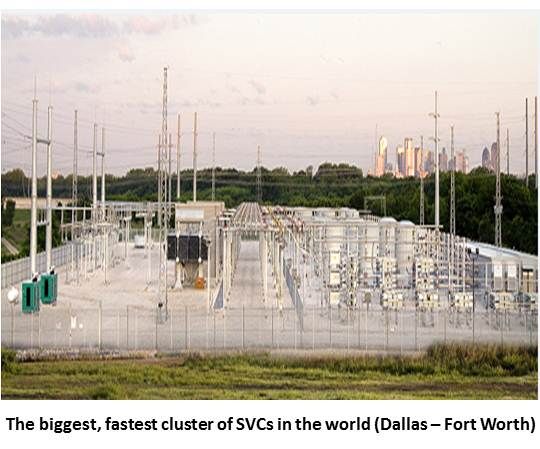Getting renewables to consumers’ light switches and electrical outlets is a lot more challenging than simply plugging them in where fossil and nuclear power plants once were.
The static VAR compensator (SVC) is a key part of the new, semiconductor-driven transmission system being designed to meet that challenge. ABB, the power and automation provider, was just awarded a $50 million contract to install four SVCs for Electric Transmission Texas LLC (ETT) as part of the Lone Star State’s Competitive Renewable Energy Zones (CREZ) program.
ABB built the world’s biggest cluster of SVCs in the Dallas-Fort Worth area (not part of CREZ) in 2008-2009 and is an ongoing presence in the build-out of the CREZ program, a comprehensive transmission system expansion that, when completed in 2014, will facilitate the delivery of electricity generated at remote Texas wind and solar power plants. The new CREZ transmission could bring as much as eighteen gigawatts of wind generated electricity into Texas homes, one of the world’s largest land-based wind initiatives.
Unlike ABB’s $1 billion contract with Dutch-German transmission grid operator TenneT to build the world’s largest offshore high-voltage direct current (HVDC) system to connect Germany’s offshore North Sea wind farms to the mainland grid, the work in Texas involves an alternating current (AC) system.
AC transmission presents a different set of challenges, which is why ABB’s expertise with SVCs and the FACTS (flexible alternating current transmission systems) technologies they are part of is so important.

Start with VAR. Electricity comes, of course, when an energy source (coal, nuclear power, natural gas or renewables) is used to generate a flowing current. The tools of transmission (transformers, conductors, generators, etc.) send that current, more accurately called real power, along the wires. When it arrives at plugged-in devices or appliances, real power allows those things to do work.
There is resistance, inductance and capacitance in the tools and wires. The result is VAR, or reactive power. Reactive power subtracts from the real power in the lines but is an unavoidable byproduct of AC transmission. “Reactive power is a characteristic of the AC power system,” explained Aftab Khan, ABB Grid Systems North America Vice President and General Manager. “The practical impact of reactive power is its impact on system voltage.”
Voltage is sort of what drives the current and produces the power. Sort of. And, noted Khan, “If you are consuming too much reactive power in the process of delivering the real power, you will bring the voltage down.”
If the voltage falls too low, power will stop flowing, leading to a failure of the transmission system. For those whose attention stops at the switch and the outlet, this is important, because when the transmission system fails, the air conditioning and the television don’t work and the payment systems at the local mall stop working.
Variable renewables can create fluctuations in the flow of power, which impacts transmission system voltage. That is why those who have worked in transmission for a long time worry about renewables. Because older solar power plants and wind turbines had limited power electronics, transferring their fluctuating levels of power into the lines could affect voltage, whereas traditional generation sources include reactive power management capabilities. However, contemporary solar systems and turbines have their own VAR compensating systems to help prevent voltage fluctuations.
For the static VAR compensators in ABB’s FACTS technologies, the key term is 'static.' The voltage management is “done by high-power semiconductors,” Khan said. “There are no moving parts. It is a very fast-acting device. You can switch it very fast.” This allows fine-tuned and instantaneous management of voltage fluctuations in transmission systems. This is vital to the reliable operation of transmission systems bringing in remote power, such as renewables, though not because of renewables’ variability.
In Texas (and many other places), electricity generated by wind projects and solar power plants is delivered from remote locations where the resources are sourced and must travel long distances along AC transmission lines.

“The reason you need something fast is if you have a network where your generation is far from the load,” Khan explained, “you need to make sure that if you have a fault on a line or some other disturbance in the system that causes a disturbance in the voltage, you need to support that voltage very quickly.”
The fluctuation in voltage caused by the renewables’ variability “in power system terms is very slow,” Khan said. ABB’s SVCs “detect and react” within a fraction of a second if a transmission line is taken out by something really instantaneous like a tree falling or a lightning strike. “That happens so fast that if you didn’t have a static VAR compensator to quickly step in and support the system voltage, the voltage may collapse, because you wouldn’t be able to keep the level of power flowing. You’d end up tripping more lines and potentially causing some significant impact to the network.”
For facilitating the safe, stable delivery of remote generation, including especially renewables generation, the Texas Commission on Environmental Quality gave the $95 million system built by ABB for grid operator Oncor in the Dallas-Fort Worth area the state’s highest award for environmental excellence. In its first 10 months of operation, the cluster of SVCs successfully prevented loss of grid stability in 38 events -- thereby keeping the lights, air conditioning and pay systems operating at the malls and the TVs and computers on in Texas homes.



